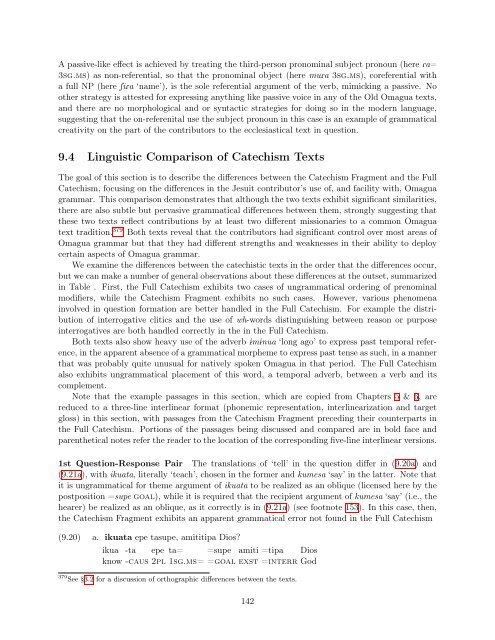draft manuscript - Linguistics - University of California, Berkeley
draft manuscript - Linguistics - University of California, Berkeley
draft manuscript - Linguistics - University of California, Berkeley
You also want an ePaper? Increase the reach of your titles
YUMPU automatically turns print PDFs into web optimized ePapers that Google loves.
A passive-like effect is achieved by treating the third-person pronominal subject pronoun (here Ra=<br />
3sg.ms) as non-referential, so that the pronominal object (here muRa 3sg.ms), coreferential with<br />
a full NP (here SiRa ‘name’), is the sole referential argument <strong>of</strong> the verb, mimicking a passive. No<br />
other strategy is attested for expressing anything like passive voice in any <strong>of</strong> the Old Omagua texts,<br />
and there are no morphological and or syntactic strategies for doing so in the modern language,<br />
suggesting that the on-referenital use the subject pronoun in this case is an example <strong>of</strong> grammatical<br />
creativity on the part <strong>of</strong> the contributors to the ecclesiastical text in question.<br />
9.4 Linguistic Comparison <strong>of</strong> Catechism Texts<br />
The goal <strong>of</strong> this section is to describe the differences between the Catechism Fragment and the Full<br />
Catechism, focusing on the differences in the Jesuit contributor’s use <strong>of</strong>, and facility with, Omagua<br />
grammar. This comparison demonstrates that although the two texts exhibit significant similarities,<br />
there are also subtle but pervasive grammatical differences between them, strongly suggesting that<br />
these two texts reflect contributions by at least two different missionaries to a common Omagua<br />
text tradition. 379 Both texts reveal that the contributors had significant control over most areas <strong>of</strong><br />
Omagua grammar but that they had different strengths and weaknesses in their ability to deploy<br />
certain aspects <strong>of</strong> Omagua grammar.<br />
We examine the differences between the catechistic texts in the order that the differences occur,<br />
but we can make a number <strong>of</strong> general observations about these differences at the outset, summarized<br />
in Table . First, the Full Catechism exhibits two cases <strong>of</strong> ungrammatical ordering <strong>of</strong> prenominal<br />
modifiers, while the Catechism Fragment exhibits no such cases. However, various phenomena<br />
involved in question formation are better handled in the Full Catechism. For example the distribution<br />
<strong>of</strong> interrogative clitics and the use <strong>of</strong> wh-words distinguishing between reason or purpose<br />
interrogatives are both handled correctly in the in the Full Catechism.<br />
Both texts also show heavy use <strong>of</strong> the adverb 1m1nua ‘long ago’ to express past temporal reference,<br />
in the apparent absence <strong>of</strong> a grammatical morpheme to express past tense as such, in a manner<br />
that was probably quite unusual for natively spoken Omagua in that period. The Full Catechism<br />
also exhibits ungrammatical placement <strong>of</strong> this word, a temporal adverb, between a verb and its<br />
complement.<br />
Note that the example passages in this section, which are copied from Chapters 5 & 6, are<br />
reduced to a three-line interlinear format (phonemic representation, interlinearization and target<br />
gloss) in this section, with passages from the Catechism Fragment preceding their counterparts in<br />
the Full Catechism. Portions <strong>of</strong> the passages being discussed and compared are in bold face and<br />
parenthetical notes refer the reader to the location <strong>of</strong> the corresponding five-line interlinear versions.<br />
1st Question-Response Pair The translations <strong>of</strong> ‘tell’ in the question differ in (9.20a) and<br />
(9.21a), with ikuata, literally ‘teach’, chosen in the former and kumesa ‘say’ in the latter. Note that<br />
it is ungrammatical for theme argument <strong>of</strong> ikuata to be realized as an oblique (licensed here by the<br />
postposition =supe goal), while it is required that the recipient argument <strong>of</strong> kumesa ‘say’ (i.e., the<br />
hearer) be realized as an oblique, as it correctly is in (9.21a) (see footnote 153). In this case, then,<br />
the Catechism Fragment exhibits an apparent grammatical error not found in the Full Catechism<br />
(9.20) a. ikuata epe tasupe, amititipa Dios?<br />
ikua -ta epe ta= =supe amiti =tipa Dios<br />
know -caus 2pl 1sg.ms= =goal exst =interr God<br />
379 See §3.2 for a discussion <strong>of</strong> orthographic differences between the texts.<br />
142
















